Defense Industry Data Security: Protecting Sensitive Data

The defense industry faces unique and evolving cybersecurity challenges, necessitating robust data security measures to protect classified and sensitive information from pervasive cyber threats originating from state-sponsored actors, cyber mercenaries, and insider risks, critical for maintaining national security and operational integrity.
The imperative of safeguarding sensitive information within the defense industry is paramount, a complex and ever-evolving challenge in the face of sophisticated cyber threats. Protecting critical data in the Defense Industry Data Security: How to Protect Sensitive Information from Cyber Threats landscape is not merely a technical endeavor but a strategic necessity, crucial for national security and military readiness.
Understanding the Landscape of Defense Industry Cyber Threats
The defense sector operates at the forefront of technological innovation, making it a prime target for adversaries seeking to gain strategic advantages through cyber espionage, sabotage, or intellectual property theft. The sheer volume and sensitivity of data, from troop movements and weapons designs to intelligence reports, elevate the stakes considerably.
This environment is characterized by persistent and highly sophisticated threats. State-sponsored actors, organized cybercrime groups, and even disgruntled insiders pose significant risks. Their motives range from stealing classified research and development data to disrupting critical infrastructure or compromising operational capabilities.
The Evolving Threat Vector
Cyber adversaries constantly adapt their tactics, employing advanced persistent threats (APTs), supply chain attacks, and sophisticated social engineering techniques. The interconnectedness of modern defense systems, coupled with the reliance on a vast ecosystem of contractors and suppliers, creates numerous entry points for attackers.
- Advanced Persistent Threats (APTs): Long-term, targeted attacks often sponsored by nation-states, designed to exfiltrate data surreptitiously over extended periods.
- Supply Chain Attacks: Exploiting vulnerabilities in third-party software, hardware, or services used by defense contractors, creating a ripple effect of compromise.
- Insider Threats: Risks posed by current or former employees, contractors, or business associates who have access to sensitive information and misuse it, intentionally or unintentionally.
- Ransomware: Although less common for direct strategic data theft in defense, it can disrupt operations and supply chains, indirectly impacting readiness.
Furthermore, the increasing adoption of emergent technologies like artificial intelligence, quantum computing, and the Internet of Things (IoT) within defense creates new attack surfaces that require proactive and adaptive security measures. Remaining vigilant and understanding the dynamics of these threat vectors is foundational to any robust defense data security strategy.
The defense industry’s unique profile, characterized by high-value targets and a complex technological footprint, mandates a continuous assessment of the threat landscape. This includes not only understanding current attack methodologies but also anticipating future trends and preparing for novel forms of cyber warfare and espionage.
Establishing a Robust Cybersecurity Framework
A comprehensive cybersecurity framework is the bedrock upon which effective defense data security is built. It moves beyond mere technological solutions, encompassing policy, people, and processes. Organizations within the defense sector must adopt a holistic approach, aligning their security posture with established national and international standards.
Frameworks such as the NIST Cybersecurity Framework, ISO 27001, and specific Department of Defense (DoD) regulations like CMMC (Cybersecurity Maturity Model Certification) provide structured guidelines. These frameworks help organizations assess risks, implement controls, and continuously monitor their security effectiveness.
Key Components of an Effective Framework
Implementing a robust framework involves several critical components that work in concert to protect sensitive information. These components are not static; they require regular review and adaptation in response to evolving threats and technological advancements.
- Risk Management: Systematically identifying, assessing, and mitigating cyber risks. This includes understanding the value of assets, potential threats, and vulnerabilities.
- Access Controls: Implementing strong authentication and authorization mechanisms to ensure only authorized personnel can access sensitive data. This includes multi-factor authentication (MFA) and least privilege principles.
- Data Encryption: Encrypting data both in transit and at rest to prevent unauthorized access even if data is intercepted or stolen.
Beyond these, continuous monitoring, incident response planning, and regular training are indispensable. A framework offers the structure needed to manage the complexity of defense data security, ensuring that all aspects, from initial design to daily operations, adhere to the highest security standards.
The adoption of a comprehensive framework fosters a culture of security throughout the organization, embedding cybersecurity considerations into every project, process, and employee mindset. This proactive stance is essential for preventing breaches and maintaining operational resilience in a hostile cyber environment.

Implementing Advanced Data Protection Technologies
While frameworks provide the blueprint, advanced technological solutions are the tools that bring defense data security to life. The speed and sophistication of cyber threats necessitate cutting-edge defenses that can detect, prevent, and respond to attacks in real-time. Simply relying on traditional firewalls and antivirus software is no longer sufficient.
Modern defense organizations must invest in a layered security architecture that leverages artificial intelligence, machine learning, and automation to enhance their defensive capabilities. These technologies offer predictive analytics, faster threat detection, and more efficient incident response.
Essential Technologies for Data Protection
Deploying the right technologies is crucial for protecting the vast amounts of sensitive data within the defense industry. This involves a strategic investment in tools that offer comprehensive protection across various vectors.
- Endpoint Detection and Response (EDR) / Extended Detection and Response (XDR): These solutions monitor endpoint and network activities for suspicious behavior, enabling rapid detection and response to threats that evade traditional defenses.
- Security Information and Event Management (SIEM): SIEM systems collect, aggregate, and analyze security event data from various sources, providing a centralized view of security posture and enabling real-time threat intelligence.
- Cloud Security Posture Management (CSPM) and Cloud Workload Protection Platforms (CWPP): As defense organizations increasingly leverage cloud environments, these tools help manage security configurations and protect workloads in the cloud.
- Network Segmentation: Dividing networks into smaller, isolated segments to limit the lateral movement of attackers in case of a breach, containing potential damage.
Furthermore, the use of hardware-level security, such as Trusted Platform Modules (TPMs) and secure boot mechanisms, adds another layer of defense against sophisticated low-level attacks. The continuous evaluation and upgrade of these technologies are vital to staying ahead of evolving cyber threats.
Implementing these advanced technologies helps create a resilient and adaptive defense system, capable of withstanding persistent attacks and ensuring the integrity and confidentiality of sensitive defense data throughout its lifecycle.
Cultivating a Culture of Cybersecurity Awareness
Even the most advanced technical defenses can be rendered ineffective if personnel lack awareness or adherence to security protocols. Human error remains one of the leading causes of data breaches. Therefore, cultivating a robust culture of cybersecurity awareness and training within the defense industry is as critical as any technological investment.
Employees, from top leadership to new recruits, must understand their role in protecting sensitive information. This requires ongoing education, not just annual training, and a clear understanding of the risks associated with their day-to-day activities.
Building a Security-Conscious Workforce
Effective cybersecurity awareness programs go beyond basic phishing simulations. They integrate continuous learning, real-world examples, and clear communication about evolving threats and best practices.
A proactive approach involves regular workshops, interactive modules, and communication campaigns that reinforce the importance of vigilance. Specific attention should be given to areas like secure remote work practices, recognizing social engineering attempts, and safe handling of classified materials.
- Regular Training & Refreshers: Continuous education on the latest cyber threats, organizational policies, and secure computing practices.
- Phishing Simulations: Regularly testing employees’ ability to identify and report phishing attempts to improve their recognition skills.
- Incident Reporting Protocols: Clearly defining and communicating how employees should report suspicious activities or potential security incidents.
- Security Champions Programs: Identifying and empowering employees within different departments to act as local cybersecurity advocates and knowledge resources.
Ultimately, a strong security culture means that every individual understands their responsibility in protecting national security information, viewing cybersecurity as an integral part of their mission, not just an IT department’s concern. This shared responsibility considerably strengthens the overall security posture.
By fostering a deep-seated understanding of cybersecurity risks and promoting best practices, defense organizations can significantly reduce their attack surface and enhance their ability to defend against even the most sophisticated threats.
The Role of Threat Intelligence and Information Sharing
In the high-stakes world of defense data security, threat intelligence is a strategic imperative. It moves cybersecurity from a reactive posture to a proactive one by providing actionable insights into adversary capabilities, tactics, techniques, and procedures (TTPs). This intelligence enables organizations to anticipate attacks, strengthen defenses, and enhance their overall resilience.
Beyond internal intelligence gathering, the defense industry benefits immensely from robust information-sharing mechanisms. Collaboration with government agencies, industry peers, and cybersecurity research institutions creates a collective defense against common adversaries.
Leveraging Collaborative Intelligence
Effective threat intelligence is timely, relevant, and actionable. It allows defense organizations to understand who is targeting them, why, and how, facilitating more precise and effective defensive strategies. Sources include open-source intelligence (OSINT), proprietary research, and governmental classified briefings.
Official intelligence frameworks and platforms, such as the Department of Homeland Security’s (DHS) Cybersecurity and Infrastructure Security Agency (CISA) and the Defense Industrial Base (DIB) sector-specific programs, facilitate the sharing of critical threat indicators and defense strategies.
- Real-time Threat Feeds: Subscribing to and integrating real-time intelligence feeds into security operations centers (SOCs) for immediate awareness of emerging threats.
- Joint Exercises & Simulations: Participating in multi-agency and industry-wide cyber exercises to test response capabilities and share lessons learned.
- Sharing Best Practices: Actively contributing to and drawing from industry forums and working groups focused on defense cybersecurity.
- Post-Mortem Analysis: Sharing anonymized details of successful attacks or thwarted attempts to inform and fortify the defenses of the broader community.
This collaborative approach ensures that defense organizations are not fighting cyber battles in isolation. It leverages the collective knowledge and experience of the entire ecosystem, significantly enhancing the ability to detect, defend against, and recover from cyberattacks. Information sharing also helps in identifying common vulnerabilities and developing standardized mitigation strategies.
By actively participating in intelligence sharing and continually refining their threat intelligence capabilities, defense entities can transform raw data into a powerful defensive advantage, safeguarding national assets and critical military operations.
Navigating Legal and Regulatory Compliance
The defense industry operates under a unique and stringent canopy of legal and regulatory requirements concerning data security. Compliance is not merely a formality but a critical component of maintaining operational authorization and avoiding severe penalties, including contract termination, financial fines, and even criminal charges. Understanding and adhering to these mandates is non-negotiable for any entity handling sensitive defense information.
Compliance frameworks like the Cybersecurity Maturity Model Certification (CMMC), International Traffic in Arms Regulations (ITAR), and Export Administration Regulations (EAR), along with various classified information handling guidelines, dictate how defense contractors and government agencies must protect controlled unclassified information (CUI) and classified data.
Adhering to Critical Regulations
Achieving and maintaining compliance requires a systematic approach, often involving regular audits, documentation, and continuous monitoring. Organizations must demonstrate not just the implementation of security controls but also their effectiveness over time.
The CMMC, for instance, mandates a tiered approach to cybersecurity, ranging from basic cyber hygiene to advanced and highly protective measures, depending on the sensitivity of the information handled and the criticality of the associated contracts. This certification is becoming a prerequisite for many DoD contracts.
- Regular Audits and Assessments: Conducting internal and external audits to ensure ongoing adherence to all applicable security regulations and standards.
- Documentation of Policies and Procedures: Maintaining comprehensive documentation of security policies, procedures, and controls, demonstrating compliance readiness.
- Training on Compliance Requirements: Educating all relevant personnel on the specific legal and regulatory obligations pertinent to their roles and responsibilities.
- Vendor and Supply Chain Compliance: Ensuring that all third-party vendors and partners who handle defense data also meet the necessary regulatory compliance standards, as the weakest link can compromise the entire chain.
The regulatory landscape is dynamic, with new requirements and updates emerging regularly. Staying abreast of these changes, integrating them into security practices, and ensuring continuous readiness for compliance evaluations are essential for remaining a trusted partner in the defense ecosystem.
Failing to comply can result in significant setbacks, from reputational damage to severe legal and financial repercussions. Therefore, integrating legal and regulatory compliance deeply into the defense data security strategy is not just about avoiding penalties, but about upholding the integrity of national security.

Future-Proofing Defense Data Security
The future of defense data security is inextricably linked to continuous innovation and adaptation. As technological advancements accelerate and cyber threats evolve in sophistication, the defense industry must proactively anticipate emergent challenges and invest in cutting-edge solutions. Future-proofing involves not just reacting to current threats but strategically preparing for tomorrow’s unknown vulnerabilities and attack vectors.
This forward-looking approach includes exploring quantum-resistant cryptography, embracing zero-trust architectures, and leveraging artificial intelligence for hyper-automated defense systems. The goal is to build security infrastructures that are inherently resilient and adaptive to unforeseen changes in the cyber landscape.
Strategic Areas for Future Security Investment
To stay ahead, defense organizations must prioritize research, development, and integration of technologies that offer a significant leap in security capabilities. This involves collaboration with academic institutions, private sector innovators, and international partners.
The move towards quantum computing, for example, necessitates the development of new cryptographic algorithms that can withstand its immense processing power, ensuring that today’s encrypted data remains secure in the quantum era. Similarly, the concept of zero trust needs to evolve from a philosophy into comprehensive, automated implementation across all defense IT environments.
- Quantum-Resistant Cryptography Research: Investing in and researching cryptographic methods that can withstand attacks from developing quantum computers.
- AI and Machine Learning for Predictive Defense: Using AI to analyze vast datasets for predictive threat intelligence, automated anomaly detection, and rapid response.
- Zero-Trust Architecture Expansion: Fully implementing zero-trust principles across all defense networks and systems, assuming no user or device is trustworthy by default.
- Enhanced Supply Chain Security: Developing more robust methods for vetting and monitoring the security posture of every component and service provider in the defense supply chain.
- Cyber Resiliency and Redundancy: Designing systems with inherent redundancy and the ability to continue operations even when under attack, ensuring mission continuity.
Furthermore, nurturing a workforce skilled in emergent technologies and advanced cybersecurity techniques will be crucial. Continuous learning and upskilling programs are essential for ensuring that human expertise keeps pace with technological advancements.
By embracing these strategic investments and fostering a forward-thinking mindset, the defense industry can build a more secure future, safeguarding sensitive information against a continuously evolving threat landscape and ensuring sustained national security.
| Key Aspect | Brief Description |
|---|---|
| 🔐 Advanced Threats | Defense faces sophisticated state-sponsored attacks, supply chain exploits, and insider risks requiring layered defenses. |
| 🛡️ Robust Frameworks | Implementing NIST & CMMC-like frameworks is essential for systematic risk management and control. |
| 🧠 Human Element | Continuous cybersecurity awareness training and a strong security culture are vital to mitigate human error. |
| 🚀 Future-Proofing | Investing in quantum-resistant crypto, AI, and zero-trust helps prepare for emerging threats. |
Frequently Asked Questions About Defense Data Security
The defense industry primarily faces threats from state-sponsored APTs (Advanced Persistent Threats), supply chain attacks, and insider threats. These adversaries aim to steal sensitive data, disrupt operations, or compromise critical national security infrastructure. Their methods are highly sophisticated and continuously evolving, demanding constant vigilance and advanced defensive measures from defense organizations.
CMMC (Cybersecurity Maturity Model Certification) is critical for defense contractors because it provides a unified standard for implementing cybersecurity controls across the Defense Industrial Base (DIB). It’s becoming a mandatory requirement for DoD contracts, ensuring contractors adequately protect sensitive unclassified information, thereby bolstering the overall security posture of the defense supply chain against cyber threats.
Encryption protects sensitive defense data by transforming it into an unreadable format, making it inaccessible to unauthorized individuals. This applies to data both at rest (stored on devices or in the cloud) and in transit (being transmitted over networks). Even if data is stolen or intercepted, without the correct decryption key, it remains unintelligible, thereby preserving its confidentiality and integrity against cyber attacks.
Threat intelligence in defense cybersecurity provides actionable insights into adversarial tactics, techniques, and procedures (TTPs). It allows defense organizations to proactively identify, anticipate, and mitigate emerging threats. By understanding who is attacking, why, and how, intelligence enables better resource allocation, strengthens defenses, and significantly enhances the ability to prevent and respond to sophisticated cyber campaigns, safeguarding national assets.
Minimizing human error in defense data security requires a robust, continuous cybersecurity awareness program. This includes regular, comprehensive training that goes beyond basic compliance, incorporating phishing simulations, real-world examples, and clear incident reporting protocols. Fostering a security-conscious culture where every employee understands and embraces their role in protecting sensitive information is paramount to mitigating the risks posed by human vulnerabilities.
Conclusion
The bedrock of national security in the 21st century rests significantly on the ability to safeguard sensitive information within the defense industry. The escalating sophistication of cyber threats demands not just continuous adaptation but a proactive, multi-layered defense strategy. By integrating robust cybersecurity frameworks, deploying advanced protection technologies, cultivating a pervasive culture of awareness, leveraging collaborative threat intelligence, and adhering to rigorous regulatory compliance, defense organizations can build resilience. This holistic approach ensures not only the confidentiality and integrity of critical data but also the sustained operational readiness and strategic advantage of nations in an ever-evolving global landscape.





